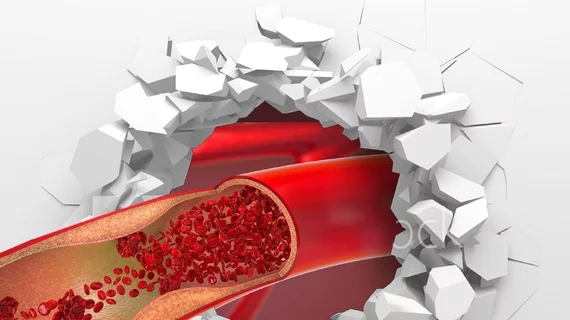Breaking Through- Have Severely Calcified Lesions Met Their Match?
• Eagerly Awaited Calcium Disruptor Arrives
• Will Atherectomy Catch the Wave?
• Need a Bigger Blast? Try a Combo Approach
• More Opportunities Along the Vascular Tree
THE FUTURE OF TREATING HEAVILY CALCIFIED LESIONS HAS ARRIVED
TOP TAKEAWAYS
• The aging population plus increases in hypertension, diabetes and chronic kidney disease have contributed to more patients having severely calcified arterial lesions. When they undergo PCI, these patients are at increased risk for complications and their interventional cardiologists face more complex procedures.
• Though interventionalists are eager for plaque-busting technologies to help break through difficult lesions, adoption of atherectomy has been limited. An analysis of CathPCI Registry data revealed that over a third of PCI-performing hospitals didn’t use atherectomy at all from 2009 to 2016.
• With the February 2021 FDA approval of the Shockwave intravascular lithotripsy (IVL) system, interventional cardiologists’ toolboxes may expand to include new technology shown to safely and effectively disrupt severely calcified lesions. In addition to complex PCI, IVL technology has potential in TAVR and “anywhere on the vascular tree,” says Dean Kereiakes, MD, co-principal investigator of DISRUPT CAD III.
• Will IVL hurt atherectomy’s small presence in the complex-PCI market? Probably not, interventionalists told CVB. They say IVL might offer atherectomy a boost if operators come to view the tools as complementary.
As more and more aging individuals with comorbidities are wheeled into cath labs, the problem of heavily calcified lesions is surging, with serious implications for clinicians and patients alike. For interventionalists, tortuous vessels can quickly turn a routine angioplasty into a complex, labor-intensive procedure. For patients, they can mean poor outcomes.
According to Shing-Chui Wong, MD, director of cardiac catheterization at New York-Presbyterian/ Weill Cornell Medical Center, up to 20 percent of patients undergoing PCI have heavily calcified lesions, and the number is expected to increase sharply in the years ahead (Circ Cardiovasc Interv 2020;13[2]:e008789). As a result, the need for more advanced technologies that can keep pace with the escalating challenge has never been more intense.
GAME ON: TECHNOLOGY RISES TO THE CHALLENGE
Fortunately, a new wave of high-performance, calcium-disrupting tools is emerging. Intravascular lithotripsy (IVL) for use in heavily calcified coronary arteries—a technology similar to the procedure that revolutionized kidney stone treatment in the early 1980s—could be a game-changer once again.
But IVL is hardly the only game in town. Atherectomy has been around for nearly three decades, and more recent improvements are expanding the market for these high-speed, plaque-busting tools. The future for treating severely calcified lesions, however, could well involve some combination of IVL and atherectomy technologies.
In this issue, we explore the range of emerging clinical strategies and how they promise to significantly change treatment.
